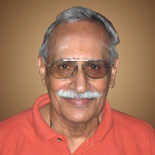|
Go to Part 41 I – Resolution through païca-koça-viveka (continued) The method (prakriyä) adopted for bringing about the resolution through correction of the five erroneous notions is called the païca-koça-viveka. The steps of the resolution are:
The resolution takes place both at the individual level (vyañöi) as well as the total level (samañöi). At the anna level, we have both the total anna and the individual annamaya. The total anna is the material cause (upädäna-käraëam) and annamaya is its product. As such, annamaya is manifested by anna, sustained by anna and goes back into anna. Total anna for the purposes of the reasoning adopted for resolution is the same as the individual annamayas. Therefore, the resolution of the individual annamaya into the individual präëamaya applies also to the resolution of the total anna into total präëa. Thus, total anna also resolves into the total präëa.
When this reasoning is applied at the levels of präëa, manas, and vijïäna, the resolution of both the individual and total also takes place simultaneously into the next higher individual and total level.
When the identification of ätmä is shifted from annamaya to präëamaya, annamaya becomes anätmä and ätmä becomes präëamaya. This is the position in terms of the reality of existence. However, in transactional terms, annamaya-koça remains unaffected by the change in its reality status into anätmä and continues to be the same as before, since its name, form and function continue to be sustained by präëamaya. The vital difference is that ätmä is now not considered as annamaya-kosa and the jéva stops saying, “I am tall”; instead, he says, “the body is tall”.
Reverting to präëamaya into which the annamaya-kosa has resolved, the Upaniñad [270] similarly reveals that ätmä is the manomaya. Thus, präëamaya becomes anätmä and is called präëamaya-koça. The präëamaya-koça, which is without intrinsic existence (mithyä), resolves into manomaya. Even as anätmä, which is mithyä, the name, form and function of präëamaya-koça continue to be as before since they are sustained by manomaya. However, ätmä becomes the manomaya and the jéva instead of saying, “I am energetic”, says, “The body is energetic”.
The Upaniñad [271] now reveals that ätmä is vijïänamaya. Therefore, manomaya becomes anätmä and is called the manomaya-koça. Being without intrinsic existence (mithyä), it resolves into vijïänamaya. Even as mithyä, manomaya-koça continues to be as before, since the name, form and function of manomaya-koça continue to be sustained by vijïänamaya. But, ätmä becomes the vijïänamaya and the jéva instead of saying, “I am mentally disturbed”, now says, “the mind is disturbed”.
The Upaniñad [272] now reveals that ätmä is änandamaya. So, vijïänamaya becomes anätmä and is called the vijïänamaya-koça. Being without intrinsic existence (mithyä), it resolves into änandamaya. Even as mithyä, vijïänamaya-koça continues to be as before since its name, form and function continue to be sustained by änandamaya. But ätmä becomes the änandamaya and the jéva instead of saying, “I am intelligent”, now says, “the buddhi is sharp”.
As regards änandamaya, it is the causal body of the jéva. The Upaniñad states that the sub-stratum or base (pratiñöhä) of änandamaya is Brahman-ätmä [273]. Thus, änandamaya becomes anätmä. Since änandamaya is dependent on Brahman-ätmä, it has no intrinsic existence. It is thus mithyä and gets mentally resolved into Brahman-ätmä. The änandamaya, which is now understood as anätmä, is called änandamayakoça. Even as anätmä, änandamayakoça continues to be the same as before, since its name, form and function continue to be sustained by ätmä. As for ätmä, it is not anything but itself and the enlightened jéva instead of saying, “I enjoyed my sleep” now says, “the sleep was undisturbed”.
We had seen earlier that the resolution of the individual and the total take place simultaneously to their next level. So, at the final stage, we have total ananda into which total vijïäna, total manas, total präëa and total anna have resolved. Total änanda is the causal body of the total and it is Éçvara. Éçvara is Brahman in mäyä-upädhi and is mithyä. This understanding of the reality status of Éçvara results in his resolution into Brahman.
While the expression ätmä is with reference to the individual, Brahman is used with reference to the total. The individual and the total having been resolved into the very same vastu, ätmä is Brahman and Brahman is ätmä.
The net outcome is that all the levels of manifestation are only anätmä, which is dependent on ätmä. Thus, not only the individual manifestation, consisting of präjïa, taijasa and viräö but also the total consisting of antaryämé, hiraëyagarbha and viräö are anätmä and are mithyä. Only ätmä-Brahman, which is self-existent, svathaù-siddhaù, and is not dependent on anything else for its existence and which is the basis of existence of everything is sat.
We may now sum up the results of the resolution of the entire manifestation into Brahman in terms of the statements of the Upaniñads:
267. Taittiréya Upaniñad, Brahma-vallé, 1. Go to Part 43
|
|||
|
|||


www.advaita.org.uk
Advaita for the 21st Century



Vedanta - Part 42
VEDĀNTA the solution to our fundamental problem
D. Venugopal

D. Venugopal is a student of Swami Paramarthananda and a direct disciple of Pujya Swami Dayananda. He has successfully completed the long-term residential course in Vedanta and Sanskrit conducted from May 2002 to July 2005 at the Arsha Vidya Gurukulam, Anaikatti.
Go to CONTENTS
Biography
Buy from Amazon UK
. Available from Bharatiya Vidya Bhavan centers at London, New York and Sydney.
. Also through the IBH Books & Magazines Distributors Pvt. Ltd. - contact contact@ibhworld.com. In case of difficulty,pvsankarankutty@bhavan.info can be contacted.
BOOK DETAILS
Publisher: Bharatiya Vidya Bhavan
ISBN: 978-81-7276-457-9
Format : Paperback
Pages: 324
List Price: US$7.00
Where to Buy
AUTHOR DETAILS

